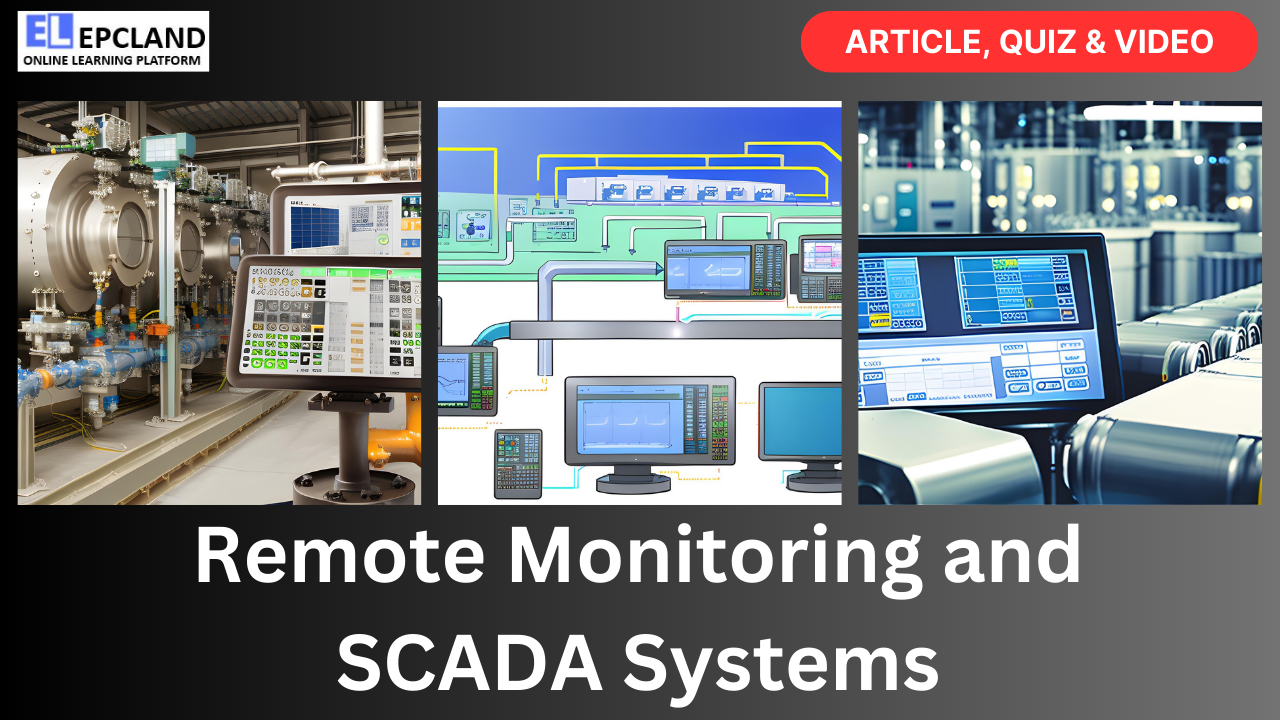The Oil and Gas Industry is a dynamic and complex sector that relies heavily on technology to optimize operations, ensure safety, and monitor critical infrastructure. Remote Monitoring and Supervisory Control and Data Acquisition (SCADA) systems have become indispensable tools in managing oil and gas projects efficiently. In this article, we will explore the role of remote monitoring and SCADA systems in the industry, their applications, benefits, and future trends.
Table of Contents
Do not miss the Complete Course on Piping Engineering
By EPCLand
Understanding Remote Monitoring and SCADA Systems
Remote Monitoring
Remote monitoring involves the use of sensors, data acquisition systems, and communication technologies to collect data from remote locations and transmit it to a central control center or a cloud-based platform. This real-time data allows operators and engineers to monitor equipment, processes, and conditions from a distance.
SCADA Systems
SCADA systems, on the other hand, are comprehensive control and data acquisition systems that enable centralized monitoring and control of various processes and equipment in industrial settings. These systems integrate hardware and software components to provide real-time data, visualization, and control capabilities.
Applications of Remote Monitoring and SCADA Systems in Oil and Gas
1. Well Monitoring and Production Optimization
Remote monitoring and SCADA systems are used extensively in oil and gas well operations. Sensors placed at wellheads and production facilities continuously measure parameters such as pressure, temperature, flow rates, and chemical composition. This data is transmitted to a central control center where engineers can analyze it in real-time. By closely monitoring well performance, operators can optimize production, detect anomalies, and prevent costly downtime.
2. Pipeline Management
Pipelines are the lifelines of the oil and gas industry, transporting hydrocarbons over long distances. SCADA systems play a crucial role in pipeline management by monitoring variables like pressure, flow, and temperature. In the event of a leak or pressure drop, the system can automatically shut down the affected section, preventing environmental disasters and economic losses.
3. Tank Farm Operations
Tank farms are storage facilities for crude oil, refined products, and chemicals. Remote monitoring and SCADA systems keep track of tank levels, temperature, and safety parameters. This information helps operators manage inventory, prevent overflows, and ensure compliance with safety regulations.
4. Refinery and Processing Plants
Refineries and processing plants rely on SCADA systems to control various unit operations, monitor equipment health, and optimize production processes. These systems enable engineers to adjust parameters remotely, respond to alarms, and maintain safe and efficient operations.
5. Offshore Platforms
Offshore oil and gas platforms operate in challenging environments, often far from the mainland. Remote monitoring and SCADA systems are crucial for real-time data transmission from these platforms to onshore control centers. They help manage production, ensure safety, and provide early warnings of adverse conditions such as storms or equipment failures.
Benefits of Remote Monitoring and SCADA Systems
| Advantages | Disadvantages |
|---|---|
| 1. Improved Safety | 1. Integration with Legacy Systems |
| 2. Enhanced Efficiency | 2. Data Security |
| 3. Cost Savings | 3. Maintenance and Reliability |
| 4. Remote Accessibility | 4. Skill Shortage |
| 5. Data Analysis and Reporting |
Do not miss the Complete Course on Piping Engineering
By EPCLand
1. Improved Safety
Safety is paramount in the oil and gas industry. Remote monitoring and SCADA systems enhance safety by continuously monitoring critical parameters and promptly detecting anomalies or safety breaches. Automatic shutdowns can be triggered in emergencies to prevent accidents and environmental damage.
2. Enhanced Efficiency
Efficiency is a key driver in the industry. SCADA systems optimize processes by allowing engineers to make real-time adjustments based on data analysis. This leads to reduced downtime, increased production rates, and lower operational costs.
3. Cost Savings
Remote monitoring and SCADA systems can lead to significant cost savings. By minimizing unplanned downtime, preventing accidents, and optimizing resource usage, operators can reduce operational expenses and maximize profits.
4. Remote Accessibility
The ability to monitor and control operations remotely is invaluable, especially in remote or offshore locations. Engineers and operators can access real-time data and make informed decisions from anywhere with an internet connection, improving responsiveness and efficiency.
5. Data Analysis and Reporting
SCADA systems provide extensive data logging and reporting capabilities. Engineers can analyze historical data to identify trends, troubleshoot issues, and plan maintenance activities proactively.
Key Components of Remote Monitoring and SCADA Systems
1. Sensors and Instruments
At the heart of any remote monitoring and SCADA system are sensors and instruments. These devices measure physical parameters such as pressure, temperature, flow, and level. In the oil and gas industry, specialized sensors are designed to withstand harsh environments and accurately capture critical data.
2. Data Acquisition Units
Data acquisition units collect data from sensors and instruments. They convert analog signals into digital data for processing and transmission. These units are essential for interfacing with the sensors and preparing data for analysis.
3. Communication Infrastructure
A robust communication infrastructure is vital for transmitting data from remote locations to central control centers. Various communication technologies are employed, including wired (such as fiber optics) and wireless (such as satellite or radio) connections. Redundancy and reliability are crucial in ensuring uninterrupted data flow.
4. Central Control Center
The central control center serves as the nerve center of the SCADA system. It houses servers and software applications that receive, process, and display real-time data. Operators and engineers use Human-Machine Interface (HMI) software to visualize data, issue commands, and respond to alarms.
5. Remote Terminal Units (RTUs)
RTUs are deployed at remote sites to interface with sensors and instruments. They collect data and transmit it to the central control center. RTUs also receive control commands from the central control center and actuate valves, pumps, and other equipment as needed.
Emerging Technologies in Remote Monitoring and SCADA
The oil and gas industry is constantly evolving, and so are the technologies used in remote monitoring and SCADA systems. Several emerging trends are shaping the future of these systems:
1. Industrial Internet of Things (IIoT)
The IIoT is revolutionizing remote monitoring by connecting an even larger number of devices and sensors. This enables more extensive data collection and analytics, resulting in improved predictive maintenance and operational efficiency.
2. Artificial Intelligence (AI) and Machine Learning
AI and machine learning algorithms are being integrated into SCADA systems to analyze vast amounts of data in real-time. These algorithms can identify patterns, anomalies, and potential issues, allowing for more informed decision-making and proactive maintenance.
3. Cloud-Based Solutions
Cloud-based SCADA systems offer scalability, flexibility, and accessibility. Operators can access data and control systems from anywhere with an internet connection, reducing the need for on-premises hardware and infrastructure.
4. Cybersecurity
With the increasing connectivity of SCADA systems, cybersecurity is a top priority. Advanced cybersecurity measures, including encryption, intrusion detection, and secure communication protocols, are being implemented to protect critical infrastructure from cyber threats.
Do not miss the Complete Course on Piping Engineering
By EPCLand
Challenges in Implementing Remote Monitoring and SCADA Systems
While remote monitoring and SCADA systems offer numerous benefits, their implementation comes with challenges:
1. Integration with Legacy Systems
Many oil and gas facilities still rely on legacy equipment and systems. Integrating modern remote monitoring and SCADA systems with these legacy systems can be complex and costly.
2. Data Security
Protecting sensitive data from cyberattacks is a constant concern. As SCADA systems become more interconnected, the risk of cyber threats increases, necessitating robust cybersecurity measures.
3. Maintenance and Reliability
SCADA systems require regular maintenance to ensure their reliability. Failures in data acquisition units, sensors, or communication infrastructure can disrupt operations.
4. Skill Shortage
Operating and maintaining SCADA systems require specialized skills. The industry faces a shortage of qualified personnel with expertise in these systems.
Future Trends and Outlook
As the oil and gas industry continues to evolve, the role of remote monitoring and SCADA systems will become increasingly vital. Here are some key trends to watch for in the future:
1. Greater Automation
Advancements in AI and machine learning will lead to greater automation of routine tasks. SCADA systems will be capable of making more decisions autonomously, further improving efficiency.
2. Enhanced Data Analytics
Data analytics will play a central role in optimizing operations. SCADA systems will become more sophisticated in analyzing data to identify trends, predict failures, and recommend optimization strategies.
3. Interoperability
Interoperability between different SCADA systems and devices will become more important. Standardization efforts will facilitate seamless data exchange and integration across platforms.
4. Environmental Monitoring
Environmental concerns will drive the integration of environmental monitoring sensors into SCADA systems. This will allow operators to track emissions, water quality, and other environmental factors more closely.
Conclusion
Remote monitoring and SCADA systems have become indispensable tools in the oil and gas industry, enabling real-time data collection, control, and optimization of critical processes and infrastructure. These systems enhance safety, improve efficiency, and offer cost savings, making them essential for the industry’s success.
As technology continues to advance, the industry will benefit from greater automation, enhanced data analytics, and increased interoperability. These trends will further elevate the role of remote monitoring and SCADA systems in ensuring the safe and efficient operation of oil and gas projects.
The challenges of integration, data security, maintenance, and skill shortages must be addressed to fully harness the potential of these systems. With the right strategies and investments, the industry can navigate these challenges and embrace the future of remote monitoring and SCADA technology.
FAQs
- What is the primary purpose of SCADA systems in the oil and gas industry?SCADA (Supervisory Control and Data Acquisition) systems in the oil and gas industry serve as centralized control and monitoring systems. Their primary purpose is to collect real-time data from remote sensors and devices, allowing operators to monitor critical processes, make informed decisions, and even control equipment remotely. They play a crucial role in enhancing safety, efficiency, and reliability.
- How do SCADA systems contribute to safety in the industry?SCADA systems contribute to safety by continuously monitoring parameters such as pressure, temperature, and flow rates. In the event of abnormal conditions or safety breaches, these systems can trigger automatic shutdowns and alarms. This proactive approach helps prevent accidents, environmental incidents, and potential hazards, ensuring the safety of personnel and assets.
- What are the key challenges in implementing remote monitoring and SCADA systems in the oil and gas sector?Implementing remote monitoring and SCADA systems in the oil and gas industry can be challenging due to several factors. These challenges include integrating modern systems with legacy equipment, ensuring robust cybersecurity to protect sensitive data, addressing maintenance and reliability issues, and coping with a shortage of skilled personnel in the field.
- How can the industry leverage emerging technologies like the Industrial Internet of Things (IIoT) in remote monitoring and SCADA systems?The industry can leverage the IIoT to enhance remote monitoring and SCADA systems by connecting a larger number of sensors and devices. This enables more extensive data collection, improved predictive maintenance, and increased operational efficiency. IIoT also facilitates remote accessibility, enabling operators and engineers to access critical data from anywhere, fostering better decision-making and responsiveness.
- What is the future outlook for remote monitoring and SCADA systems in the oil and gas sector?The future of remote monitoring and SCADA systems in the oil and gas sector looks promising. Key trends include greater automation, enhanced data analytics, increased interoperability between systems and devices, and a focus on environmental monitoring. These advancements are expected to further enhance safety, efficiency, and sustainability in the industry, making these systems increasingly vital for its success.
Do not miss the Complete Course on Piping Engineering
By EPCLand
Recommended courses (Published on EPCLand)
- Basics of Piping Engineering
- Piping Layout Engineering
- Piping Material Engineering
- Piping Stress Analysis
- Complete Course on Piping Engineering
- Material Requisitions
- Piping Material Specifications
- Valve Material Specifications
Don’t miss the published articles on following:
| Data Analysis and Technology with Link | Data Analysis and Technology with Link |
| Data Analytics | Industrial Control Networks |
| Machine Learning | The Power of Acoustic Sensors |
Related Video
Attempt Quiz
Question 1:
What does SCADA stand for in the context of oil & gas projects?
Explanation: SCADA stands for Supervisory Control and Data Acquisition, and it is used for monitoring and controlling various processes in oil & gas projects.
Question 2:
What is the primary purpose of a remote monitoring system in oil & gas projects?
Explanation: The primary purpose of a remote monitoring system in oil & gas projects is to remotely monitor and manage equipment and processes for improved efficiency and safety.
Question 3:
What types of data are typically collected and transmitted by SCADA systems?
Explanation: SCADA systems typically collect and transmit real-time operational data, alarms, and status information for monitoring and control purposes.
Question 4:
What is the significance of cybersecurity in remote monitoring and SCADA systems for oil & gas?
Explanation: Cybersecurity in remote monitoring and SCADA systems is significant because it ensures the availability and integrity of critical systems, protecting them from cyber threats and vulnerabilities.
Question 5:
What are some benefits of using SCADA systems in oil & gas projects?
Explanation: Some benefits of using SCADA systems in oil & gas projects include increased operational efficiency, reduced downtime, and better decision-making through real-time data monitoring and control.



